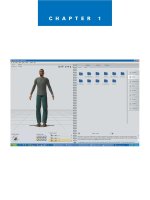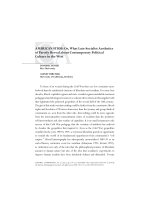Human Figure in Charcoal potx
Bạn đang xem bản rút gọn của tài liệu. Xem và tải ngay bản đầy đủ của tài liệu tại đây (346.42 KB, 20 trang )
Human Figure in Charcoal
Drawing people and figure art is exciting and challenging in any medium -
in this short art lesson we will produce a fairly small rendering of the female
nude in vine charcoal.
Charcoal is typically a medium to be loved or loathed. In an instant it can
create those rich blacks that any graphite artist will envy, having squandered
hours to achieve the same result. However, there comes a price, and that
price is dust. Charcoal (particularly vinecharcoal) will do its utmost to
distribute itself wherever it can: on fingers, under nails, unwanted smears
across your page, usually everywhere except the very place you wanted it.
My own brief experiences with this ill-behaved medium have met against
some resistance, until recently and somewhat ironically, I found dust to be a
solution. I tried an experiment by grinding charcoal into fine powdery form
and then painting it onto the paper, with instantly improved results, and it is
these techniques I would like to share with you now.
Equipment
A
Sandpaper
Ideal for grinding down charcoal, or sharpening it to a
point.
B Vine Charcoal
Assorted sizes. (note: vine charcoal is made from the
willow tree).
C Vine Charcoal
This came from the garden of John Ruskin, and was
formed in larger sticks, though essentially it is the
same as B.
D Chamois
Bought from a car shop and can be used to blend.
E Colour Shaper
A rubber tipped tool designed for blending and
shaping pastel/charcoal and paint (available in
artshops and on the Internet).
F
Charcoal/Pastel
Pencils
Charcoal can be bought in pencil form. It saves
fingers from becoming blackened, and can be easier
to control. The white pastel pencil can be used for
highlights.
G
Compressed
Charcoal
Not as messy as the vine charcoal sticks, but is harder
to erase.
H Putty Eraser
A crucial piece of equipment that removes charcoal
without leaving a mess.
I Container
An old tic-tac sweets container to hold the charcoal
dust. Use whatever you like, but preferably something
with a lid.
J Brushes
Two cheap brushes that can be used to push the dust
around on the paper.
Fixative - Brushing dry charcoal dust around
with a brush makes it difficult to apply a dark
tone in one take; spraying fixative allows me
to build up two or maybe three layers to get
the darker tones.
The larger can was the cheapest I could find,
and as a consequence I have to spray three
times as much to get any use from it. My
recommendation would be to invest in
something half-decent. The Windsor and
Newton fixative may be smaller, but it is
much more effective and ultimately lasts
longer.
Paper - You can use any paper from pastel
paper (Canson is particular good from my
previous pastel painting efforts), watercolour
paper to bristol board. For the purposes of this
article I have bought a pad of Charcoal Paper
made by Daler-Rowney. It is 'laid' paper,
giving it a texture that helps hold the charcoal,
and is slightly tinted.
Creating Dust
This is the messy (and
fun) part! With your
vine charcoal in hand,
sand it down over a
piece of folded paper
(I've used an old
envelope). If you do
not have any spare
sandpaper, you should
still be able to create
dust by rubbing your
charcoal on a piece of
paper. Take caution
not to breathe in the
dust.
You will probably
need to obliterate two
sticks, and once done
carefully pour the dust
into a container for
safekeeping.
Making a Point
When drawing people,
facial details can be
very fiddly when
working small and
working in charcoal as
it does not have the
pinpoint accuracy of a
sharpened pencil. If
you rub it down you
can form a sharp edge
for more detailed
work. Do not expect
the sharp edge to last
long though.
Outlines
The initial outline does not have
to be inspiring in-itself, and can
be reworked throughout the
drawing, however some level of
accuracy is required if you wish
to keep areas of your page clean
for later highlights. If your lines
go astray a piece of putty should
soon put it to rights as vine
charcoal is very malleable - you
might even get away with
rubbing out areas with a clean
finger.
Seeing negative shapes helps a
great deal when marking out the
human figure, for example, the
triangle between the sloping back
and left arm, or the shape
between the left thigh and right
breast. I started the drawing with
the arm and back so that I could
size the head to fit.
Applying the Dust
I used an old soft
brush for this. One
that is too coarse
(such as hog's hair)
will scrape the dust
particles, which may
find a use in another
drawing, but not for
this one.
This step is fairly
messy, but I am
unconcerned about
particles finding
their way into my
outline: dust
particles are easily
removed providing
they have not been
pushed in too hard
with the brush.
Even before I put
brush to paper,
particles were
falling off onto the
page.
By working the
background first,
the darkest tones
are established
and provide a
tonal reference to
more accurately
apply the
highlights and
middle-ranged
tones for the body
and face.
The dust particles
create miniature
plumes of 'smoke'
that are
fascinating to
observe, but try
not to breathe it
in. Better to work
in a ventilated
room and keep
your head at a
distance.
I dip the brush
into the powder as
necessary, but try
not to leave an
excessive amount
of dust on the
page. I know that
if the dark is not
as dark as I would
like, I can always
spray a little
fixative and repeat
this stage at a later
time.
Cleaning the
Consequent Mess
Using my smaller
brush I go over the
lines of my drawing
to soften the edges
and remove a little
of their blackness.
The brush I am
using is a cheap
Cotman size 111
watercolour brush.
After two drawings
it looks slightly
sorry for itself, so
my advice is please
do not use your best
kolinsky sable
brushes!
Applying Tones
This is the stage
where I stop and
look at what I have
so far with a little
despondence.
Many artistic
endeavours can
look quite feeble in
their early stages.
With a little
perseverance I am
confident it will
take shape.
I adopt a different
approach to each
of my
drawings/paintings
. In this instance I
want to finish the
head before
proceeding. No
fixative has been
sprayed and so it is
imperative I keep
my hand off the
paper.
Details
Using a piece of
sharpened vine
charcoal I start
working on the
details. At this
size things can be
a little fiddly, but
when mistakes
happen the putty
can be moulded
into small thin
points to put
things right.
I have darkened
the area around
the head in an
attempt to better
define the face. At
a later stage I plan
to darken the
entire
background.
Hair
The colour shaper
I'm using has a fine
chiseled tip and I
use this to put in a
few finer
suggestions of hair.
I find the tool a little
unpredictable in that
sometimes it
removes charcoal
and sometimes it
places charcoal.
Pressure is a factor
in this.
Toning the Body
I'm moderately
happy with the
head at this stage,
though plan to
return to it later. I
use a little fixative
on the face and
background, and
then darken the
background with
another layer of
charcoal dust.
For the tones on
the back and body
I dip the small
brush into the
dust, give it a
small tap to
remove any
excessive loose
particles and then
brush it onto the
paper using a
putty where
necessary.
Highlights
I used the pastel
pencil to add a few
highlights where
needed, but try to go
sparingly. White
pastel reflects light
dependent on the
angle of your light
source so it is
recommended to
view your work
from several
different angles to
try and ensure you
are not over doing
the highlights.
Foreground
A shadow below
the figure helps
give it a position
within the
drawing, and I
start to make a
few suggestions
of things in the
foreground, again
careful not to
touch the drawing
with my fingers as
even with fixative,
charcoal can be a
volatile medium.
Finishing
I work the leg in a
similar way to the
body, then touch up
and blend a few
more areas before
giving it a good
spray of fixative so I
can scan the image
without the charcoal
falling away.
There are lines,
features and shading
that I know could be
improved upon, but
I'm content to call it
a day. Hopefully if
nothing else, it helps
demonstrate that
charcoal needn't be
an artist's enemy.
Incidentally, I was
not particularly
impressed with
Daler-Rowney's
charcoal paper.
Even without
relayering, the paper
had taken as much
charcoal as it could
take (see right thigh)
and slowly started
beading!









